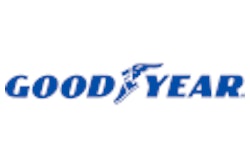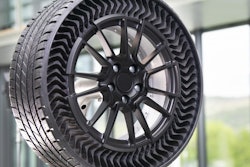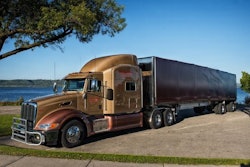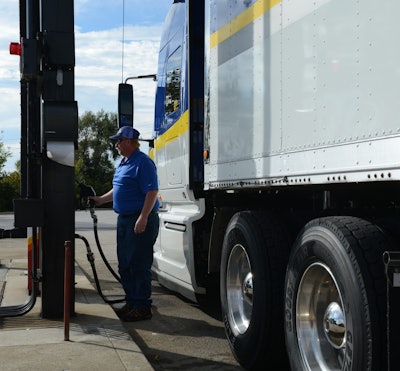 The tread’s deformation can cause half of a tire’s rolling resistance, and LRR tires are designed to reduce that energy loss, according to Goodyear.
The tread’s deformation can cause half of a tire’s rolling resistance, and LRR tires are designed to reduce that energy loss, according to Goodyear.What are the biggest factors affecting your fuel economy? Engine inefficiencies are first, followed by aerodynamic drag. Then comes the rolling resistance of your tires. The biggest factor in that resistance, and the easiest and cheapest to address, is inflation.
Imagine rolling two basketballs, one inflated correctly and one lacking pressure, says Tom Clauer, a senior manager with Yokohama Tire. “The one with the correct air pressure will roll much faster and further due to its [lower] rolling resistance,” he says.
Tires inflated to the recommended pressure should perform well. But if those tires are not designed for low rolling resistance, there could be more savings to grab by investing in tires built for that purpose.
 Bridgestone Americas Greatec M835A Ecopia ultra-wide-base drive tire has a high-rigidity tread pattern to help enhance tread life, even wear and low rolling resistance.
Bridgestone Americas Greatec M835A Ecopia ultra-wide-base drive tire has a high-rigidity tread pattern to help enhance tread life, even wear and low rolling resistance.Tire makers achieve lower rolling resistance by manipulating aspects that include casing materials, rubber compounds and tread designs to stabilize ribs and blocks. These things affect the tires’ tread depth, mileage range and traction.
“A tire’s tread can account for up to half of a tire’s rolling resistance,” says Mahesh Kavaturu, Goodyear’s commercial technology director. LRR tires seek to reduce the amount of energy lost through tread deformation, he says.
“This can be achieved by reducing the tread block’s height, by stabilizing the tread elements using higher angle drafts, by designing the tread elements to take more rigid shapes or by increasing the surface area of the tread block to increase its stiffness,” he says.
Tire makers test rubber compounds for new products in part by evaluating “rebound.”
“Think of bouncing a rubber ball,” Kavaturu says. “The higher the ball bounces, the less energy it has lost in its collision, or deformation, with the ground. Compounds with good rebound properties tend to exhibit lower rolling resistance.”
Weighing the tradeoff
One widely held belief is that an LRR tire’s lifespan is shorter than that of a standard tire. Mike Graber, Toyo’s director of sales for commercial truck tires, says that is true only because the LRR tire usually starts with less tread depth off the rack. The rubber itself doesn’t actually wear measurably faster.
“When measuring miles per 32nd of an inch of tread, the difference between the two is much closer,” he says.
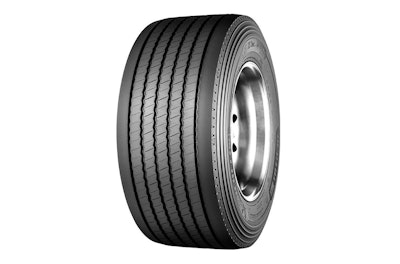 Michelin’s 455/55R22.5 X One MultiEnergy T wide-base single trailer tire is designed for regional operations and is engineered for fuel economy and reduced irregular wear.
Michelin’s 455/55R22.5 X One MultiEnergy T wide-base single trailer tire is designed for regional operations and is engineered for fuel economy and reduced irregular wear.“The deeper the tread blocks, the better the grip and wear, but the worse for fuel economy,” says Sharon Cowart, product marketing director for Michelin North America. “However, through tire design, it is possible to utilize technologically advanced compounds and tire construction techniques to minimize a tire’s rolling resistance while striving to maintain other performances. There are some design options available that can lower the rolling resistance in areas not related to grip or other performances — internal components, for example.”
Customers who haven’t tried LRR tires in years might be surprised at the improvements.
“Tire manufacturers have been able to increase the tread depths of LRR steer and drive tires and still maintain fuel savings with newer tread compounds and casing designs,” says Chuck Luther, Northeast sales manager for Triangle Tire USA. “In most cases today, LRR tires are capable of achieving comparable or better overall mileage than conventional non-LRR tires.”
Graber says traction tires generally have a higher content of natural rubber, which tends to be softer and offer more grip and cut and chip resistance. Synthetic rubber contributes to lower rolling resistance but comes with a tradeoff on traction versus a standard tire with the same tread pattern.
“From a rolling resistance standpoint, a perfectly smooth rubber surface with no pattern would be ideal,” says Marco Rabe, Continental’s head of truck tire technology for the Americas region. “However, this would come at the cost of traction and wet-snow performance.”
Luther says as long as the tread design is conducive to the environment in which the tires are used, most users won’t notice any difference in traction, adding it all goes back to proper inflation.
“Always inflate tires to the tire manufacturer’s recommended air pressure for the load carried,” he says. “This, in many ways, goes against conventional wisdom of 100 psi in all wheel positions. However, proper air pressure to load carried translates into better traction, better fuel efficiency and casing longevity.”
Measuring the savings
Continental recently participated in an independent third-party test using its 11R22.5 LRR tires. In the long-haul segment, the tires delivered a fuel economy of 7.35 mpg. According to the 2018 Annual Fleet Fuel Study from the North American Council for Freight Efficiency, the national average is 5.91 mpg.
Based on an annual average of 105,014 miles, burning more than 17,773 gallons of fuel per year – at $3.89 per gallon – Continental’s fuel-efficiency improvement accounts for $13,500 per truck.
While every operation differs, Cowart says, a rule of thumb for line-haul applications is that “a 3 percent reduction in rolling resistance translates into a 1 percent fuel savings, or an increase of .05 miles per gallon.” Additional savings come with retreading the casings, provided their condition merits it.
As tires have evolved, improvements in constructions and rubber compounding have led “to lower heat generation in the casing, which creates a very retreadable tire,” says Phillip Mosier, Cooper Tire’s manager of commercial tire development. Reducing heat reduces rolling resistance, but Rabe says it also improves the likelihood that a casing can be retreaded.
Applications that run at consistent steady speeds – such as long-haul and regional – stand to reap the most benefits from an investment in LRR tires, which in some cases cost more than comparable tires that are not LRR.
“Applications such as [pickup and delivery] or on- and off-road benefit less from low rolling resistance compounding because the engine and brakes make a higher contribution to fuel economy,” Mosier says.
In applications such as on- and off-road and waste operations – where there is a high probability of damage, frequent starts and stops, multiple turns and loose material slippage – it’s difficult to measure the benefits of LLR tires, Clauer says.
“Of course, fuel savings can be had in any operation and application, but the tradeoff may make it a moot point,” he says.
Some trailer owners consider the trailer a place to mount tires nearing the end of their lifecycle, but tire makers say that’s a mistake.
“The trailer axle tire position contributes 35 to 40 percent of the tire rolling resistance and therefore should be considered as a valuable position for fuel-saving tires,” says Luther.
Continental research puts the figure higher. It shows the impact on rolling resistance is 15 percent from the steer axle, 42.5 percent from the drive axle and 42.5 percent from trailer axles.


